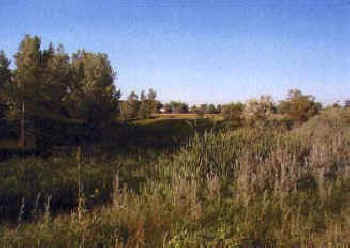Viele Lake Channel 25 Years Later
by
Kenneth R. Wright and Jonathan E. Jones
Wright Water Engineers, Inc.
In 1968, with the Urban Drainage and Flood Control District’s new Urban Storm
Drainage Criteria Manual undergoing review and comment by dozens of drainage engineers
and many agencies, the District, City of Boulder (City), and the Colorado Department of
Highways (CDOH) decided to try out the "new approach" to drainage. The site
selected for a new major drainage system was the South Boulder Road interchange at US 36.
Fortunately, the engineers for the three agencies agreed to go with "the new
environmental approach to drainage."
When Ken Wright of Wright Water Engineers (WWE) was given the assignment by the CDOH in
1968, he perused the draft chapters on major drainage and detention storage and went to
work with the new 100-year storm runoff criterion. The result of WWE’s design was a
series of inflow and outflow culverts for the cloverleaf-enclosed area so that, during a
100-year storm runoff, the outlet conduit would create a backwater, causing water to
temporarily pond within the cloverleaf. Wright gave the CDOH the option of either a wet or
dry pond, and they selected the dry pond to create an open expanse of grass with a narrow
wetland channel along the south side.
The north cloverleaf loop was handled in somewhat the same way, with a narrow earthen
channel filled with wetland vegetation where maintenance would be easy and low-cost. The
biggest decision for the District and the City was the downstream Viele Lake flood control
channel. Here, WWE specified a wide, flat bottom with 4:1 side slopes and a rather flat
grade so that wetland vegetation could keep its feet wet. A high roughness factor was
selected to account for future vegetation. The major drainage system at the interchange
was completed in 1969. The downstream channel was constructed in 1974, with Bill DeGroot
serving on his first construction assignment with the District. Ted Dieffenderfer, long
time engineer for the City, was also on the project to help insure that the channel would
serve its intended function.
 |
 |
Viele
Lake Channel downstream from US 36 in 1975 and 2000. |
As time passed, the downstream flood control channel was all but forgotten as cattails
and bulrushes flourished and Great Plains cottonwoods took hold on the 4:1 side slopes of
the channel. At the same time, willows decided that they liked the environment. All this
happed without much notice because the new flood control channel needed no maintenance; it
was left to do its own thing. Neither WWE nor the agencies realized that the Thorne
Ecological Institute moved into a new office right next to the channel. Over a period of a
couple decades, Dr. Oakleigh Thorne, founder and president of the institute, watched the
channel mature and operate. Thorne contacted WWE last July about the channel and reported:
- "We observe [the channel] daily outside our office window. . . about 50 yards away.
This channel is----a popular nesting area for red-winged blackbirds, who are present in
high concentrations during the nesting season. The channel appears to be a highly valuable
wetland area----song sparrows and common snipe also nest here.
- "Several years ago, when we had heavy rains on the Bear Creek watershed, this
channel filled up completely with floodwater (up to the top of the rock gabion corner
where the channel does a right-angle turn by our office). This was early in the spring, in
late April, I believe, and the new year’s growth of cattails had not yet shown. The
water flowed over and completely covered the old tan cattails. Where we usually had a
cattail swamp, we suddenly had a full-fledged river! It carried the heavy load of water
extremely well.
- "During the flood period, I observed that the male red-winged blackbirds, which had
been holding territories in the cattails, became very agitated and chased all other
"intruder" birds from their territories. On one occasion, I saw a male try to
chase a "foreigner" female (of the same species) from his territory. The two
"tangled" in midair "face to face" flapping wildly. The fighting two
descended down into the water, whereupon the male held the head of the female under the
water until she eventually drowned. Her head bobbed up a few times, but all in vain---the
male kept pushing her head under the water. When he finally flew up from the water, the
female never again reappeared above the surface. I have never observed anything like this
in all my six decades of bird watching."
Viele Lake channel downstream from the Boulder Turnpike, designed and constructed in
accordance with the new criteria manual, has already observed its 25th
birthday, and it was a happy birthday for the song sparrows, common snipes, and red-winged
blackbirds. It was also a happy birthday for the maintenance people simply because they
didn’t have anything to do there.
[ Cover Story ] [ Viele Channel ] [ Tucker Talk ] [ Master Planning ] [ Stormwater Permits ] [ Construction ] [ Maintenance ] [ South Platte River ] [ Professional Activities ] [ Awards ] [ Software ] [ Seminar ] [ Floodplain Management ] [ Flood Warning ]
|

